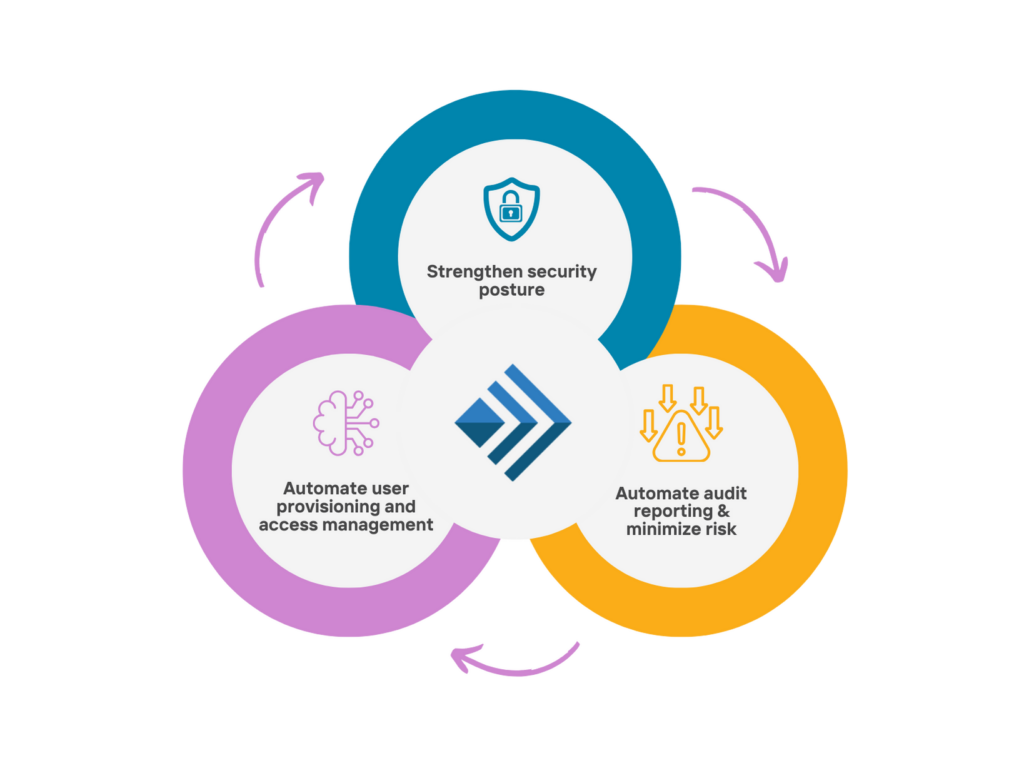
Every January, the Simeio go-to-market team gathers for our global kick-off to reflect, re-calibrate, share best practices, and listen to customers and partners, all aimed at advancing and attaining customer excellence. As part of this year’s kick-off, our team was honored to host a customer panel of identity leaders and practitioners where they discussed the driving trends around digital identity management and PAM.
This experience provided a unique perspective on the driving trends and developments of the digital identity management industry. We hope that, by sharing these insights with the greater community, the collective quality of IAM services will improve. Here are five key takeaways and considerations when implementing, maintaining, and expanding a digital identity management program in 2024.
1. Minimize the Blast Radius of Breach Events
Cybersecurity is a two-sided coin. On the one hand is prevention, wherein you must stop threats from getting into your systems. The other, less glamorous yet just as vital, is the standard of remediation after the threat has penetrated your systems. According to one of our panelists: “in the event that somebody comes into the identity environment, you need to know how to minimize the blast radius. Not if it’s going to happen, but when it’s going to happen. ”
The speaker further emphasized that addressing breaches is a top priority internally, suggesting that cybersecurity and identity concerns could take precedence over essential business objectives. After all, a catastrophic data breach can cause a business to gain unwanted long-lasting notoriety as was the case with the 2013 Target HVAC breach. Some businesses have been hit so hard by breaches that they were forced to shut down entirely.
The need for constant evolution in response to threat actors is a key driver for the cybersecurity and identity management space. Fortunately, Simeio’s digital identity management customers are well prepared to handle both hacking attempts and ongoing breach events. To mitigate the impact, ensure you have responses to the 6 Identity and Access Security Questions that every practitioner should have in their arsenal. Through capabilities such as active monitoring and role-based access controls, users can rest assured that they have a secure perimeter not just around their identity fabric but around each individual identity.
2. Data is Key for IAM growth
One of the most frequently-echoed talking points was the topic of aggregating key metrics and analytics accurately. Accurate data collection is not only important for active decision making on an IT level, but crucial for charting an accurate roadmap. One of the most effective starting points for greater transparency in identity is an identity assessment or IAM maturity benchmarking. However, such measures can be difficult to carry out internally.
Industry experts agree that developing a pragmatic identity roadmap is a crucial element in achieving successful digital transformation. However, that roadmap must be informed by meaningful metrics which enable accurate analytics. Oftentimes, enterprises lack the internal expertise necessary to even begin collecting the appropriate data, much less how to properly extrapolate from it. “Identity helps make the daily unknowns of business into known risks and manages them.”
Simeio is experienced in identity practices, including compliance and improving identity maturity. We focus on automated metrics and analytics, emphasizing authenticity verification and aligning with client goals. We understand each enterprise’s unique needs and provide customized accelerated solutions as a managed identity service provider. The role of a managed identity service provider is to identify the user’s unique needs and build out an effective response to it.
3. Act fast to enable PAM
Of all the IAM pillars, the one most overdue for its time in the limelight is Privileged Access Management. One panelist described how PAM is not only an important feature in of itself, but a crucial enabler for other modernizing features. “Everybody’s looking at PAM, which is a meaningful change in the industry from the technology perspective” they said. “The SSO, MFA, and cloud components of PAM are vital to modern workstreams.”
PAM works to centralize controls, enable automation in cybersecurity, and greatly expedite migrations. With PAM coming to the front burner for the first time, there’s a gap in knowledge and resources. With PAM coming to the front burner for the first time, there’s a gap in knowledge and resources. Enterprises with a robust IAM platform should be thinking multiple steps ahead and if their provider can roll out or integrate a PAM solution quickly.
Ask the if PAM is a major component to your current managed identity service program, or is it still on the backburner? Many enterprises are seeking to remediate this gap by turning to a knowledgeable managed identity services provider. Simeio integrates PAM as a major component of all rollouts we do and a critical facet of the Simeio Identity Orchestrator platform.
4. Make Identity Management a Top Priority
A challenge the panelists discussed was the lack of ROI from identity investments. “Cybersecurity doesn’t run as an income generator.” As a result, the lack of buy-in for their critical activities hits close to home for them. “We (the identity experts) are often an afterthought with the cybersecurity teams. But identity management is the user-experience side of security.”
Convincing high-level decision makers about the important effects of identity can be difficult when all they see are pain points and are not informed how they are being resolved. One of the important approaches to identity advocacy discussed by the panelists involved how the program is initially recommended by a potential vendor. “I want a conversation, not a product pitch,” they explained. “Have that iterative conversation and find out what they are having trouble with.”
As previously stated, the current talent shortage is impacting enterprises’ ability to resolve their PAM needs internally. However, a managed identity service like Simeio resolves that issue through the delivery of a ready-made team. These certified experts that rollout projects with clear ROI and analytics which are easily digestible by the C-suite. Additionally, our pure focus on identity allows us to start from scratch with no infrastructure or to accommodate preexisting architecture.
5. Zero-trust – how to define it and what’s your role?
The final point which our panelists hit upon was the long-overdue move towards zero trust architecture. However, one of the emerging difficulties of zero trust is how much difficulty there seems to be in defining it. “Everybody’s definition of zero trust is different,” they said. Ultimately the best and simplest definition of zero trust is that it is more of a paradigm shift than a shiny new technology. Simeio explains it through the simple phrase, “Never trust, always verify.” This translates to always authenticating any interactions with digital systems, relying upon features like adaptive MFA and SSO to avoid friction.
Much like incidents which would have been mitigated by PAM, the industry is no stranger to what-ifs revolving around how zero trust could have prevented disaster. Advocacy groups like the IDSA are making headway in becoming the new standard. However, the onus falls upon individual companies to adopt effective zero trust architecture.
Simeio has diligently advocated for zero trust and helped implement it whenever possible in our customers architecture. Just as we prioritize PAM, zero trust aligns seamlessly with our promotion of MFA and SSO. Partnering with a provider who offers and enables solutions for IAM, PAM, and zero trust positions your company for success and sustainable growth.
Modernizing Your Digital Identity Management for 2024
Each of these digital identity management trends for 2024 work best if considered and implemented together. Perhaps that means educating your internal identity teams about emerging trends. Or maybe your priority is to augment their capabilities with a managed identity service. In either case, your first step is getting the pulse of the industry figured so you can figure out your own way forward. It is highly recommended that you take a long hard look at the state of your cybersecurity, audit/risk, and efficiency metrics.
Because the companies which will survive the rigors of the coming year will be the ones who take these lessons to heart.

